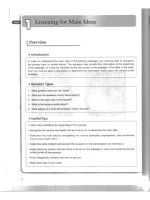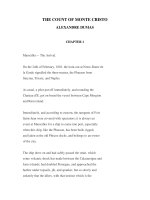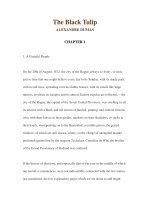Algebal review 1 pps
Bạn đang xem bản rút gọn của tài liệu. Xem và tải ngay bản đầy đủ của tài liệu tại đây (132.94 KB, 6 trang )
Vocabulary
It is essential in geometry to recognize and understand the terminology used. Before you take the SAT, be sure
you know and understand each geometry term in the following list.
acute angle an angle that measures less than 90°
acute triangle a triangle with every angle that measures less than 90°
adjacent angles two angles that have the same vertex, share one side, and do not overlap
angle two rays connected by a vertex
arc a curved section of a circle
area the number of square units inside a shape
bisect divide into two equal parts
central angle an angle formed by an arc in a circle
CHAPTER
Geometry
Review
This chapter reviews key skills and concepts of geometry that you need
to know for the SAT. Throughout the chapter are sample questions in
the style of SAT questions. Each sample SAT question is followed by
an explanation of the correct answer.
7
95
chord a line segment that goes through a circle, with its endpoints on the circle
circumference the distance around a circle
complementary angles two angles whose sum is 90°
congruent identical in shape and size; the geometric symbol for congruent to is Х
coordinate plane a grid divided into four quadrants by both a horizontal x-axis and a vertical y-axis
coordinate points points located on a coordinate plane
diagonal a line segment between two non-adjacent vertices of a polygon
diameter a chord that passes through the center of a circle—the longest line you can draw
in a circle. The term is used not only for this line segment, but also for its length.
equiangular polygon a polygon with all angles of equal measure
equidistant the same distance
equilateral triangle a triangle with three equal sides and three equal angles
exterior angle an angle on the outer sides of two lines cut by a transversal; or, an angle outside
a triangle
hypotenuse the longest leg of a right triangle. The hypotenuse is always opposite the right
angle in a right triangle.
interior angle an angle on the inner sides of two lines cut by a transversal
isosceles triangle a triangle with two equal sides
line a straight path that continues infinitely in two directions. The
geometric notation for a line through points A and B is A
ෆ
B
ෆ
.
line segment the part of a line between (and including) two points. The geometric notation for
the line segment joining points A and B is A
ෆ
B
ෆ
. The notation A
ෆ
B
ෆ
is used both to
refer to the segment itself and to its length.
major arc an arc greater than or equal to 180°
midpoint the point at the exact middle of a line segment
minor arc an arc less than or equal to 180°
obtuse angle an angle that measures greater than 90°
obtuse triangle a triangle with an angle that measures greater than 90°
ordered pair a location of a point on the coordinate plane in the form of (x,y). The x represents
the location of the point on the horizontal x-axis, and the y represents the
location of the point on the vertical y-axis.
–GEOMETRY REVIEW–
96
origin coordinate point (0,0): the point on a coordinate plane at which
the x-axis and y-axis intersect
parallel lines two lines in a plane that do not intersect. Parallel lines are marked by a symbol ||.
parallelogram a quadrilateral with two pairs of parallel sides
perimeter the distance around a figure
perpendicular lines lines that intersect to form right angles
polygon a closed figure with three or more sides
Pythagorean theorem the formula a
2
+ b
2
= c
2
, where a and b represent the lengths of the
legs and c represents the length of the hypotenuse of a right triangle
Pythagorean triple a set of three whole numbers that satisfies the Pythagorean theorem,
a
2
+ b
2
= c
2
, such as 3:4:5 and 5:12:13
quadrilateral a four-sided polygon
radius a line segment inside a circle with one point on the radius and the other point at
the center on the circle. The radius is half the diameter. This term can also be
used to refer to the length of such a line segment. The plural of radius is radii.
ray half of a line. A ray has one endpoint and continues infinitely in one direction.
The geometric notation for a ray is with endpoint A and passing through point B
is AB
.
rectangle a parallelogram with four right angles
regular polygon a polygon with all equal sides
rhombus a parallelogram with four equal sides
right angle an angle that measures exactly 90°
right triangle a triangle with an angle that measures exactly 90°
scalene triangle a triangle with no equal sides
sector a slice of a circle formed by two radii and an arc
similar polygons two or more polygons with equal corresponding angles and corresponding sides
in proportion
slope the steepness of a line, as determined by , or
ᎏ
y
x
2
2
Ϫ
Ϫ
y
x
1
1
ᎏ
, on a
coordinate plane where (x
1
, y
1
) and (x
2
, y
2
) are two points on that line
solid a three-dimensional figure
square a parallelogram with four equal sides and four right angles
supplementary angles two angles whose sum is 180°
vertical change
ᎏᎏᎏ
horizontal change
–GEOMETRY REVIEW–
97
surface area the sum of the areas of the faces of a solid
tangent a line that touches a curve (such as a circle) at a single point without cutting
across the curve. A tangent line that touches a circle at point P is perpendicu-
lar to the circle’s radius drawn to point P
transversal a line that intersects two or more lines
vertex a point at which two lines, rays, or line segments connect
vertical angles two opposite congruent angles formed by intersecting lines
volume the number of cubic units inside a three-dimensional figure
Formulas
The formulas below for area and volume will be provided to you on the SAT. You do not need to memorize them
(although it wouldn’t hurt!). Regardless, be sure you understand them thoroughly.
Circle
Rectangle Triangle
r
l
w
h
b
A = lw
C = 2πr
A = πr
2
Cylinder
Rectangle
Solid
h
l
V = πr
2
h
w
r
h
V = lwh
C = Circumference
A = Area
r = Radius
l = Length
w = Width
h = Height
V = Volume
b = Base
A
=
1
2
bh
–GEOMETRY REVIEW–
98
Angles
An angle is formed by two rays and an endpoint or line segments that meet at a point, called the vertex.
Naming Angles
There are three ways to name an angle.
1. An angle can be named by the vertex when no other angles share the same vertex: ∠A.
2. An angle can be represented by a number or variable written across from the vertex: ∠1 and ∠2.
3. When more than one angle has the same vertex, three letters are used, with the vertex always being the
middle letter: ∠1 can be written as ∠BAD or ∠DAB, and ∠2 can be written as ∠DAC or ∠CAD.
The Measure of an Angle
The notation m∠A is used when referring to the measure of an angle (in this case, angle A). For example, if ∠D
measures 100°, then m∠D ϭ 100°.
1
2
A
C
D
B
vertex
ray #1
ray #2
–GEOMETRY REVIEW–
99









